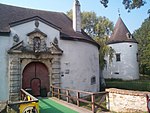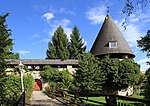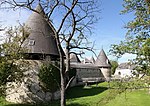Kobersdorf Castle
Kobersdorf Castle is a castle in the market town of Kobersdorf in the state of Burgenland in Austria .
history
The castle was built around 1528 from a medieval castle , the origins of which probably go back to the time of Ludwig the German . "Kundpoldesdorf" is mentioned in a Salzburg almanac as early as 860; Whether this place coincides with Kobersdorf can only be guessed as well as the assumption that at that time there was a fortress against the Avars at the site of the castle .
It was not until 1229 that Kobersdorf was referred to as " villae, que est aput castellum ". This was the first time that the castle and settlement were fixed in writing. As early as 1222, King Andreas II. Count Pousa, son of Botus, gave the area around Kobersdorf as a gift, whereupon he began to build the castle.
After a checkered history - in 1289 the castle was captured for the first time as part of the Güssing feud - Kobersdorf came into the possession of the Mattersdorf-Forchtensteiners through sale . With their extinction around 1450, Duke Albrecht VI. the lordships of Kobersdorf and Forchtenstein, but already in 1451 was forced to transfer them to his brother Emperor Friedrich III. continue to sell.
For the emperor, who resided in Wiener Neustadt , the castles of Forchtenstein , Kobersdorf and today's castle ruins of Landsee were of particular strategic importance. However, the pawnbrokers Weisspriach appointed by him turned to the Hungarian King Matthias Corvinus , whereupon he donated the castle to the Weisspriachern in 1466 in a historically not yet fully clarified action, although it was still legally in Austrian possession at that time.
In 1482 the new owners begin to expand the castle with a late Gothic outer bailey and the Protestant chapel; In 1529 Hans von Weisspriach expanded the outer bailey into a palace in the Renaissance style .
The Weisspriacher family died out in 1553; rule is increasingly divided among the heirs. Unclear ownership and indebtedness led to the decline of the once so splendid court life on Kobersdorf: the castle became the headquarters of robbers, counterfeit coinage and even the scene of a crime in 1599, when a farmer's wife was burned as a supposed witch in the middle of the castle courtyard .
It was not until Johann I. Kery de Ipoliker married a great-granddaughter of the last Weisspriacher in 1648 that the situation was clear again: The count, who came from Eastern Hungary, bought up the splintered parts of the rule and in 1656 completed the palace extension in the mannerist style .
In 1683 the castle was taken by the Turks; the actual castle, which had existed next to the palace until then, was destroyed. The Kerys felt compelled to sell the rule to Prince Paul I Esterházy de Galantha in 1704 .
Now slipped into the shadow of the Esterházy residences in Eisenstadt and Fertőd , Kobersdorf Castle remained neglected from 1704 onwards. On the one hand, this had the great advantage that the palace was essentially spared the typical baroque changes of the 18th century, on the other hand, it also fell into disrepair until 1963, finally, a demolition of the ruins was considered.
Martha Bolldorf-Reitstätter , Austria's first female academic architect, acquired the devastated castle in 1963 and immediately started the renovation work. The high point of the restoration work is the completion of the Mannerist knight's hall (1656, with frescoes by the Italian painter Carpoforo Tencalla ) in 2001, which had to be almost completely reconstructed. The endeavor of the owners was to develop Kobersdorf into a cultural center, which was achieved in 1972 with the establishment of the Kobersdorf Castle Games .
With the death of Martha Bolldorf-Reitstätter in 2001, at the age of 89, the castle in its current state passed to her daughter Anna Schlanitz.
Castle chapel
The free-standing Kobersdorf Castle Chapel is a particularly valuable object in terms of cultural history. It consists of two chapels built next to each other: the smaller of them was later converted into the sacristy of the larger Gothic chapel. It shows Romanesque- early Gothic features and is believed to have been built together with the castle around 1222 to 1229. The decoration with late Gothic frescoes was carried out around 1430 on behalf of the Forchtensteiners. Under the frescoes there is also their coat of arms, which is the oldest surviving representation of the later Burgenland coat of arms.
The Gothic chapel was built in 1482 by the Weisspriachers and was consecrated to Protestants . It was the Weisspriach who spread Protestant doctrine in Kobersdorf. But when Count Kery moved in in 1648, there was a militant re-Catholicization , which was reflected in the structure of the chapel: the gallery typical of Protestant chapels was removed, the Gothic entrance walled up and a new entrance in the style of the early Baroque was built. The interior was also decorated in a mannerist style. A special feature are the 48 individual angels floating on the ceiling, some of which are very much based on the grotesque of the Renaissance. The altar itself comes from the Esterházys and was built in the early 18th century in the Baroque style.
Occasional masses take place in the chapel (for example soul masses, May devotions ); it is also possible to rent them for weddings and baptisms.
Picture gallery
North entrance with barbican and corner tower
See also
Web links
- Schloss Kobersdorf: Website of Schloss Kobersdorf (German, Hungarian and English; accessed November 7, 2008)
- Entry via Schloss Kobersdorf to Burgen-Austria
- Aerial photos of Kobersdorf Castle
Coordinates: 47 ° 35 ′ 51 ″ N , 16 ° 23 ′ 34 ″ E








